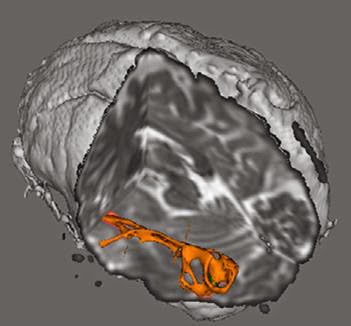What is White Matter in the Brain
 |
| ("Gallery - The brain's other half: picturing the white matter - Image 1 - New Scientist") |
Think of the nervous system as a computer network. The gray matter in the brain is like the computers in the network. The while white matter is the cables connecting the computers.
"White matter is that part of the brain made of cells called ‘axons' that connect one to the other so that nerves can communicate. White matter enables the brain to operate intact."
UC Davis Department of Neurology - News - White Matter Matters: UC Davis neurology researchers ... (n.d.). Retrieved February 14, 2015, from http://www.ucdmc.ucdavis.edu/neurology/newsroom/white_matter_feature.html
White Matter and
How Children Learn to Read
“You know where the color of your eyes came from, your facial features, your hair, your height, and even your personality traits, but what we’re trying to find out, by looking at brain networks and accounting for everything in the environment, is where your reading ability originates.”
Fumiko Hoeft, a cognitive neuroscientist and psychiatrist currently at the University of California, San Francisco
Hoeft studies the neuroscience of reading development. In a recently published study, Hoeft and her associates found that only one thing consistently predicted how well a child would learn to read. That was the growth of white matter in one specific area of the brain, the left temporoparietal region. The amount of white matter that a child arrived with in kindergarten didn’t make a difference. But the change in volume between kindergarten and third grade did.
Konnikova, M. (n.d.). How Children Learn To Read. Retrieved February 14, 2015, from http://www.newyorker.com/science/maria-konnikova/how-children-learn-read?mbid=social_facebook
White Matter Behaves Differently in Children With Dyslexia
Dr. Laurie Cutting of Vanderbilt University is also studying white matter in the brain. Dr. Cutting is a part of a team of researchers using neuroimaging to examine structural differences in connectivity in children with dyslexia as compared to typically developing readers.
Her recent study of another area of the brain, the sub-cortical thalamus region, found, “A different pattern of thalamic connectivity … in the dyslexic group in the sensorimotor and lateral prefrontal cortices. “These results suggest that the thalamus may play a key role in reading behavior by mediating the functions of task-specific cortical regions,” Cutting said.
The thalamus acts a the brain’s connector. It relays sensory and motor signals back to the cerebral cortex via white matter. The thalamus also regulates alertness, consciousness, and sleep.
 |
| Fiber Pathways in the brain http://news.vanderbilt.edu/files/brain-thalamus.jpg |
Cutting and her colleagues have also studied the the left occipito-temporal region. This is known as the visual word form area.
“Findings suggest that the architecture of the left occipito-temporal region connectivity is fundamentally different between children who are typically developing readers and those with dyslexia,” Cutting said.
"The typically developing readers showed greater connectivity to linguistic regions than the dyslexic group. Those with dyslexia showed greater connectivity to visual and parahippocampal (memory encoding and retrieval) regions."
“Together these studies suggest anomalous patterns of subcortical and cortical connectivity that may underlie the functional abnormalities in the left occipito-temporal region in individuals with dyslexia,” Cutting said.
'White matter' behaves differently in children with dyslexia. (n.d.). Retrieved February 14, 2015, from http://news.vanderbilt.edu/2014/10/dyslexia-white-matter/
